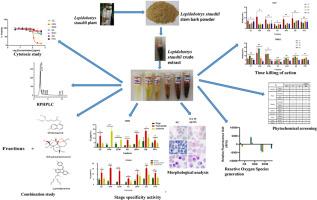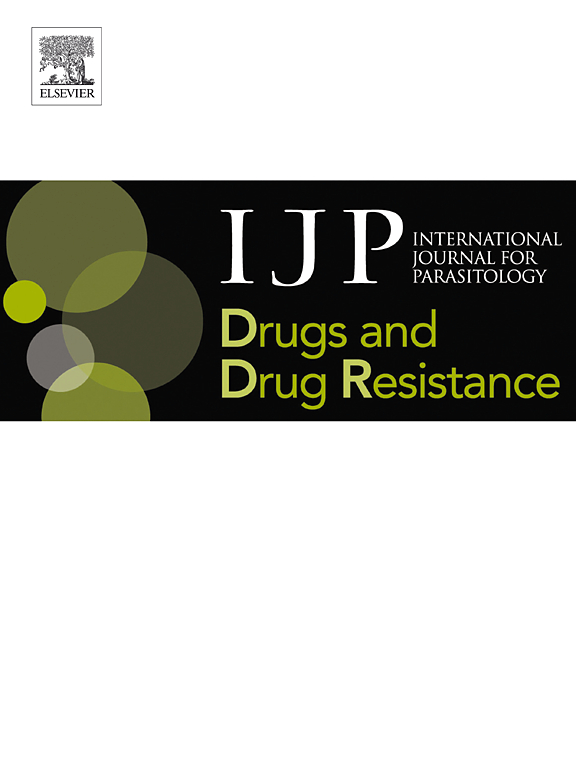In vitro antiplasmodial activities of extract and fractions from Lepidobotrys staudtii against sensitive and resistant blood-stage parasites of Plasmodium falciparum
IF 3.4
2区 医学
Q1 PARASITOLOGY
International Journal for Parasitology: Drugs and Drug Resistance
Pub Date : 2025-08-25
DOI:10.1016/j.ijpddr.2025.100610
引用次数: 0
Abstract
Antimalarial resistance is a primary challenge in the treatment of malaria. The ongoing search for novel drug sources remains a critical strategy for addressing this issue. This study evaluated the blood stage antiplasmodial and cytotoxic activities of the crude extract and fractions obtained from Lepidobotrys staudtii. The crude extract and all fractions exhibited promising antiplasmodial activity (IC50 < 10 μg/mL) against all the tested Plasmodium falciparum strains (Pf3D7 drug-sensitive and PfINDO chloroquine-resistant). Notably, the hexane and ethyl acetate fractions exhibited the highest potency, with IC50 values of 3.73 and 3.4 μg/mL (Pf3D7), respectively. No cytotoxic effects were observed at concentrations of up to 500 μg/mL. The ethyl acetate fraction displayed rapid action (12 h of exposure) against the Pf3D7 and PfINDO strains. The ring stage parasites were particularly susceptible to the fractions, with IC50 values ranging from 2.17 to 4.87 μg/mL (Pf3D7) and 2.27–6.27 μg/mL (PfINDO). Additionally, combining the fraction with standard antimalarials at fixed sub-inhibitory concentrations significantly reduced IC50 values. Only the hexane and crude extracts stimulated reactive oxygen species (ROS) production, whereas the other fractions neutralized the ROS. The most potent ethyl acetate fraction arrested parasite developmental progression and merozoite egress. Phytochemical analyses revealed the presence of phenols, flavonoids, tannins, alkaloids, saponins, carbohydrates, glycosides, and proteins. Reverse Phase High Performance Liquid Chromatography (RP-HPLC) analysis revealed that the fractions comprised a diverse array of compounds, resulting in varying levels of parasite-killing. This study emphasizes the blood-stage antiplasmodial properties of the stem bark extract and fractions of L. staudtii, underscoring their potential as a promising source of antimalarial agents.

石纹鳞翅目提取液及提取物对恶性疟原虫敏感和耐药血期寄生虫的体外抗疟原虫活性研究
抗疟药耐药性是疟疾治疗的主要挑战。正在进行的寻找新的药物来源仍然是解决这一问题的关键战略。本研究评价了石竹鳞翅果粗提物和提取物的血期抗疟原虫活性和细胞毒活性。粗提物及各组分对所有恶性疟原虫(Pf3D7药敏和PfINDO氯喹耐药)均表现出良好的抗疟原虫活性(IC50 < 10 μg/mL)。其中,己烷和乙酸乙酯的IC50值最高,分别为3.73和3.4 μg/mL (Pf3D7)。当浓度高达500 μg/mL时,未观察到细胞毒性作用。乙酸乙酯部分对Pf3D7和PfINDO菌株具有快速作用(暴露12 h)。环期寄生虫对各组分的IC50值分别为2.17 ~ 4.87 μg/mL (Pf3D7)和2.27 ~ 6.27 μg/mL (PfINDO)。此外,将该组分与固定亚抑制浓度的标准抗疟药结合使用可显著降低IC50值。只有己烷和粗提物刺激活性氧(ROS)的产生,而其他部分中和活性氧。最有效的乙酸乙酯部分阻止了寄生虫的发育进程和裂殖子的产生。植物化学分析揭示了酚类、类黄酮、单宁、生物碱、皂苷、碳水化合物、糖苷和蛋白质的存在。反相高效液相色谱(RP-HPLC)分析显示,这些组分由多种化合物组成,导致不同程度的寄生虫杀灭。本研究强调了石竹藤茎皮提取物和部分的血期抗疟原虫特性,强调了它们作为抗疟药物的潜力。
本文章由计算机程序翻译,如有差异,请以英文原文为准。
求助全文
约1分钟内获得全文
求助全文
来源期刊

International Journal for Parasitology: Drugs and Drug Resistance
PARASITOLOGY-PHARMACOLOGY & PHARMACY
CiteScore
7.90
自引率
7.50%
发文量
31
审稿时长
48 days
期刊介绍:
The International Journal for Parasitology – Drugs and Drug Resistance is one of a series of specialist, open access journals launched by the International Journal for Parasitology. It publishes the results of original research in the area of anti-parasite drug identification, development and evaluation, and parasite drug resistance. The journal also covers research into natural products as anti-parasitic agents, and bioactive parasite products. Studies can be aimed at unicellular or multicellular parasites of human or veterinary importance.
 求助内容:
求助内容: 应助结果提醒方式:
应助结果提醒方式:


